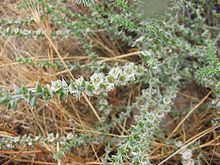Scientific name Kali Rank Genus | ||
 | ||
Lower classifications Kali turgidum, Kali tragus | ||
Kali is a genus of plants in the subfamily Salsoloideae in the amaranth family, Amaranthaceae. Common names of various members of this genus include tumbleweed for its wind-blown seed dispersal habit, and Tartar thistle and Russian thistle for its origins.
Contents
These species were previously part of the genus Salsola.
Systematics
The type species of the genus is Kali turgidum. The genus consists of ca. 23 species:
In 2014, Mosyakin et al. proposed to conserve Salsola kali (= Kali turgidum) as nomenclatoral type for the genus Salsola. If the proposal will be accepted, all species of genus Kali would belong to Salsola again.
Invasive Species
Several species, most notably the central Asian Kali tragus, are invasive species outside their native range. They have encroached into parts of North America, where they are listed as noxious weeds by the United States Department of Agriculture. The salt-tolerant genus was first reported in the United States around 1877 in Bon Homme County, South Dakota, apparently transported as a stowaway in flax seed exported by Ukrainian farmers. South Dakota proved too harsh and dry for growing flax, however, and by 1900 Kali had colonized as far west as the Pacific Coast. It was also actively introduced by the USDA as experimental food for cattle that could be grown in hard times during droughts. Palatability of the young shoots is considered to be fair. Cattle, sheep, and horses eat it if nothing better is available. Small rodents and pronghorn also graze on the young shoots. Kali thrives wherever land use has disturbed the soil. It can be seen in Death Valley, California, and in Colorado at elevations of 8500 feet (2600 m).
